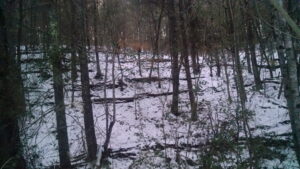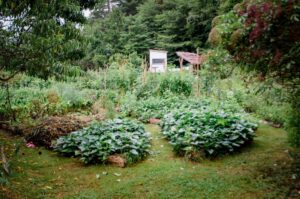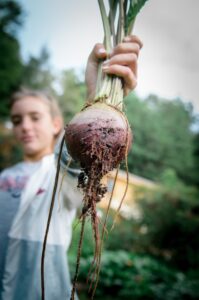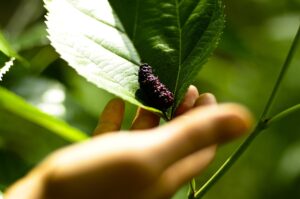Perennial crops are some of our favorites. They’re the starlets of the permaculture world for many reasons. Not the least of which is that once they’re established, they keep giving and giving with (usually) less maintenance than annuals. There are tons of different perennial crops, from giant trees to tiny ground covers. Indeed, each has its own contributions to make to a diversified permaculture garden, lush backyard or production farm.
In this primer, we’re going to share some perennial basics, starting with a definition. If you’re excited about learning more, please join us for our Permaculture Design Certificate immersion. In it, students get to meet (and eat) many locally adapted perennial crops and talk with experts about how to propagate and manage them.
Annual, Biennial, Perennial
Different plants live for different amounts of time, and it takes different plants varying lengths of time to mature and produce seed. Enter the terms annual, biennial and perennial.

Annual is probably a familiar term. It’s used in reference to many non-plant activities that take place once a year. Plants with this designation grow from a seed, mature, produce their own seed, and die, all within the cycle of one year. Many familiar garden vegetables are annuals – for example, tomatoes, zucchinis, cucumbers, green beans, peppers, okra, lettuce, spinach, etc.
Biennial plants take two years to complete their life cycle. In general, they grow vegetatively during the first year (just leaves and stems, no flowers). Then, in their second year of life, they grow flowers that eventually ripen into seeds. Some examples of common biennial vegetables are carrots, beets, onions and celery.
Perennials live for more than two years. In many cases, much more than two years. Ancient redwood trees are perennials, as are wild and cultivated berry bushes, all fruit trees, and many garden herbs like sage, rosemary and thyme (not parsley; it’s a biennial). In our climate, some perennials are cultivated like they’re annuals. We replant these each year because freezing winter temperatures kills them, but we like having them around. In warmer climates, there would be no need to replant. Perennial vegetables are a lesser-known group of perennials that we especially love. Click here to learn about 10 of our favorite perennial vegetables.
Ecological Benefits of Perennials
Perennials have larger, more established and often deeper root systems than annual plants. Because they get to grow in the same place, year after year, their roots get to keep growing, too. And it’s these root systems that provide many of the ecological benefits of perennial plants.


Roots of perennials can help prevent and mitigate erosion, especially on slopes. In fact, they provide an underground structure that holds soils in place. Additionally, management of many perennials involves heavy mulching (either of the plants’ own trimmings or of another material that’s brought in), which further helps hold soil in place on hillsides and other vulnerable places.
Well-established root systems also “mine” minerals and other nutrients from the soil. They actually pull up nourishment from deep in the soil. Perennial plants use these nutrients to grow their leaves, branches, flowers and fruits – and then relocate those nutrients onto the soil surface when they’re pruned or when they drop their leaves. Furthermore, some of this deep-soil richness is moved to higher layers of soil as nutrients are exchanged between plant roots and soil life.


While the roots are down there “mining,” they’re also “tilling.” But roots don’t act like plows, loosening soil by turning it over and destroying the strata (layers). Instead, they help cultivate the earth by penetrating deeply without disturbing the natural structure. This allows more water and oxygen to get in, which in turn paves the way for the biological activity that helps make soils rich and fertile.
The longer-lived aboveground parts of perennials make a contribution, too. They house insects, including pollinators and beneficials. Additionally, they can provide shade and windbreaks.
Perennial Plants in Natural Systems
In natural systems that haven’t been manipulated by humans, there is usually a mix of annual, biennial and perennial plants. Indeed, these diverse types of plants work together to clean the air, to keep the soil covered and healthy, to provide food for the myriad organisms that co-create the ecosystem, and to provide the stunningly complex beauty that characterizes planet Earth.
Apart from landslides and fresh lava flows, Nature doesn’t choose to plant primarily annual crops in her garden. In contrast, human farming systems are sometimes 100% annuals, and we even harvest most biennials after their first year (beets, carrots, celery, onions, etc.). This practice can quickly lead to soil degradation and to reduction of habitat for beneficials – not to mention more work on the part of the farmer, who must prepare the soil and replant every year.


With all these benefits, you may be wondering why more people don’t plant perennials. Well, a big reason is that they usually take time to get established. Most perennial plants don’t bear a crop their first year; if they do, it’s usually a small one. So, planting perennials is a long-term investment. Also, many great perennial crops (especially perennial vegetables), are not well-known. We want to change that! Check out some of our favorite resources below (some by guest instructors in our programs). Or, join us for our Permaculture Design Certificate immersion to get hands-on experience with these generous plants.
Recommended Resources
If you want to find these books locally, more power to you! If you want to buy them online, we participate in an affiliate program with Amazon.com, and when you click on the links below, we benefit. The money that we make from this program goes into a fund to help us continue to offer free information to everyone.
Perennial Vegetables: From Artichokes to Zuiki Taro, A Gardener’s Guide to Over 100 Delicious and Easy to Grow Edibles by Eric Toensmeier
How to Grow Perennial Vegetables: Low-Maintenance, Low-Impact Vegetable Gardening by Martin Crawford
The Resilient Farm and Homestead: An Innovative Permaculture and Whole Systems Design Approach by Ben Falk
The Carbon Farming Solution: A Global Toolkit of Perennial Crops and Regenerative Agriculture Practices for Climate Change Mitigation and Food Security by Eric Toensmeier
The Holistic Orchard: Tree Fruits and Berries the Biological Way by Michael Phillips
Creating a Forest Garden: Working with Nature to Grow Edible Crops by Martin Crawford
Gaia’s Garden: A Guide to Home-Scale Permaculture, 2nd Edition by Toby Hemenway





